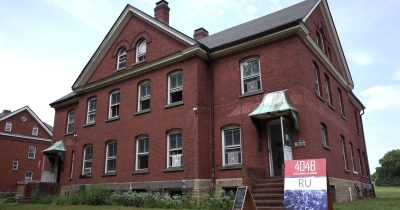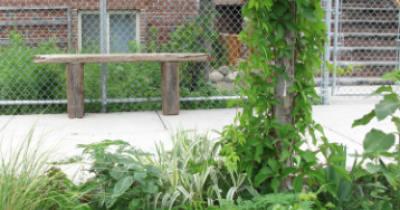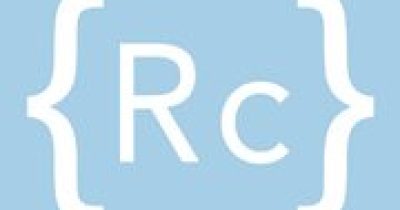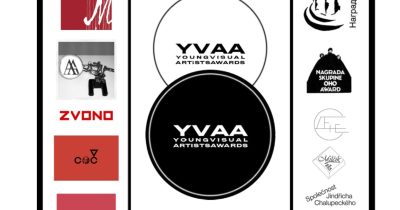The Fine Arts Museums invited artist Ana Prvački, known for her participatory projects that use humor as a means to disarm traditional museum activities and behaviors, to visit and imagine a project that uses the museum experientially, rather than as an exhibition venue. In the resulting project, Detour, Prvački leads visitors around the museum to look anew at the building, grounds, and collections, and imagine different ways of viewing, connecting, and behaving.
In a special collaboration with Google Arts & Culture, short videos will be accessible on mobile devices, triggered at various spots throughout the museum to guide visitors through this alternative tour. With wit and playfulness at their core, each video addresses a different idea, relating the de Young’s context to topics ranging from ancient myth to personal intimacies, environmental matters to vision exercises. In addition to creating dialogues with collection objects and immediate surroundings, two sculptures will be installed in connection with the project.
Prvački is a cross-disciplinary artist whose works take the form of diverse projects that draw on performance, daily practices, consumer aesthetics, and popular concerns. Her projects foreground experimentation in content and form, their ephemeral nature both a strategy for creating unique experiences and a nod to an environmentally conscious artistic practice. She has realized solo exhibitions and projects at the UCLA Hammer Museum, Los Angeles; the Isabella Stewart Gardner Museum, Boston; and the Castello di Rivoli Museo d’Arte Contemporanea, Turin. Her work has also been included in many international exhibitions, including the 14th Istanbul Biennial and dOCUMENTA 13. Her performances have been commissioned by the LA Philharmonic and the Chicago Architecture Biennial, among others.
Ana Prvački: Detour will be installed in the de Young’s public spaces; no admission required.
Videos produced in collaboration with Revelator, Austin and Director of Photography Jonn Herschend.
Interview with Ana Prvački
Ana Prvački at the de Young in October 2017. Photo by Rosa Tyhurst
Elizabeth Thomas, Director of Public Engagement for the Fine Arts Museums, spoke with Prvački to find out more about what inspires her work.
You often enter institutions that have offered very open invitations. How do you approach thinking about what to do?
I have always been interested in protocols and gestures that ameliorate the discomforts of daily life and, in this context, how these affect and apply to both institutions and their staff and to visitors. Most of the time these concerns overlap with my own concerns and preoccupations, so ideally we work together and in dialogue to make life more bearable, or at least more poetic or humorous.
I know that you make work that actively tries to minimize its own ecological and economic footprint. Why is this important to you?
Throughout my career the key focus of my art practice has been the development of ideas and concepts rather than the production of large objects, I think that conceptual art is low carbon footprint in its essence. Our current and urgent situation on this planet requires a commitment to making work that is sustainable, both in theory and practice, by which I mean the research and development of works that do not require elaborate production, shipping, or storage. We need to make less and imagine more, tread lightly on this earth.
Imagination and invention are central to your work, as they are to many artists, but you apply it to very different realms, and often within the everyday, or as small gestures. Can you talk about scale and context with your work?
I think this is again connected to the question of ecology and conceptual practice. I was reading about Neolithic art and how during that period you had two types of art: it was either permanent, meaning on an immovable rock or inside a cave, or it was portable and nomadic, made to be carried easily. I think we need to return to that kind of regulating of scale. Not only is it respectful to the planet, but it also has the ability to be experienced and disseminated in a much more subversive manner.
Can you speak about your most recent performance in Chicago, in the context of the botanical gardens?
L’air pour l’air is a collaborative piece I developed with SO-IL architects, initially commissioned for the Chicago Architecture Biennial. We wanted to address the pressing issue of our environment and air pollution with a lyrical gesture, and with the belief that to be able to play and make poetry and culture, we need to be able to take deep and full breaths, without fear. We created air-altering mesh enclosures for musicians that have been designed to clean the air through breath. The more music that is played, the cleaner the air. I am thinking about very similar issues at the de Young and its location in Golden Gate Park, as it is where people come to breathe and feed both their lungs and their soul.
Can you explain why you’re licking the building in the accompanying photo, since it might give people a window into your thought processes?
I am quite fascinated by the copper facade of the museum. I did some research about copper and was intrigued to learn that copper is an essential trace mineral necessary for our survival, yet it is a mineral our body does not produce by itself. It turns out oysters have a perfect balance of zinc and copper to give us the most benefits; however, they are in danger of extinction and most people can’t afford them. Having a little lick of the de Young could be a very generous gesture—democratic, free, and nourishing.




